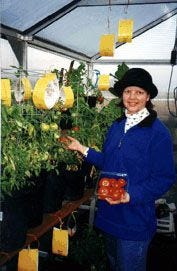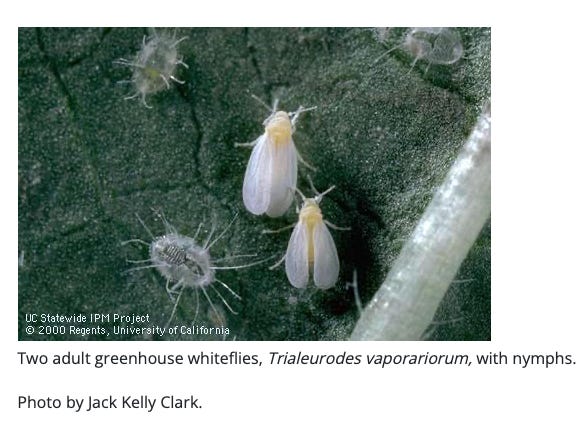Growing Tomatoes in the Winter, Indoors
The right tomato varieties make all the difference for winter tomato success
If you really want to demonstrate to your friends what a great investment your greenhouse is, nothing beats serving them home grown tomatoes...on Valentine’s Day.
Here's What You'll Need to Grow Greenhouse Tomatoes for the Winter and Spring:
A greenhouse or an indoor area with lots of light and heat. On line, check out the selection at Washington State-based Charley's Greenhouse. Also, check out the Sturdi-Built greenhouses of Portland, Oregon. Here in Northern California, there's the Greenhouse Megastore in West Sacramento.
The Right Tomato. For the typical hobby greenhouse (8x5, 8x10, 8x12), cool season "determinate" tomatoes are best. These tend to be fairly compact plants (under 4 feet tall) that do not put on lots of growth after they set fruit. Determinate tomatoes usually ripen at the same time; so, choose several tomatoes that will ripen at different times, going from seed to fruit in 50-70 days. To minimize disease problems, choose tomatoes that have "built-in" disease resistance. These will have the letters "V" (verticillium wilt-resistant), "F" (fusarium wilt) "N" (nematodes), "T" (tobacco mosaic virus) and "A" (alternaria fungus) after the variety name of the tomato.
A "Warm Greenhouse" or indoor room. This is one that maintains a nighttime temperature range of 55-70 degrees, preferably above 60 degrees for tomatoes. Daytime temperatures should range from 75-85 degrees. A heater, in conjunction with a thermostatically controlled vent fan, can easily provide that temperature range here in the Valley and foothills.
Sunlight. Tomatoes need full sun, at least six hours of direct sun a day. Try to position your greenhouse so that it can take best advantage of the low angle of the sun during the cold months, making sure the building isn't shaded by any evergreen trees or other structures.
Artificial light. Because of the lower intensity of the sun and the possible persistence of fog and low clouds during the winter, you will need a lighting system to supplement any natural light. Although there are many artificial lighting systems available, fluorescent lights are the most economical. Use four, 40-watt, 48-inch long fluorescent tubes side by side, keeping them 8-12 inches above the plants. Although standard "shop lights" are OK, investing in Gro-Lux wide spectrum fluorescent tubes will give your tomatoes more of the light spectrum that they can use. For the latest in grow light technology, including LED's, check this page at Charley's Greenhouse.
Water. Although the cooler temperatures of the fall and winter will cut down on the amount of water that tomatoes need, a drip system connected to a timer will insure that the plants get the moisture they need. Four to eight gallons of water per week per plant should be plenty.
Soil. Planting directly into the ground of the greenhouse is OK, as long as the soil drains readily, has been amended with organic matter and isn't compacted. Building raised beds into the floor of your greenhouse works best. Make the sides of the raised bed 8-16 inches high, and at least 18 inches wide. The bed can be framed by a number of things, including untreated wood, blocks, bricks, or stacked old tires. Growing tomatoes indoors in plastic 5-gallon or 15 gallon pots works well, too. There are a lot of good container soil mixes on the market for tomatoes and vegetables, including Gardner & Bloome, Recipe 420, Black Gold, Dr. Earth and Fox Farm.
Hydroponic Systems. The technology for these has changed radically since I last used one, decades ago. Check with your local hydroponics store or nursery for more information about the latest and greatest. Online, take a look at the hydroponic systems and reviews at Amazon.
Fertilizer. Because plants tend to slow down their growth in the colder months, cut your dosage of your favorite tomato fertilizer by half. For example, if the directions for a water-soluble fertilizer say to add 1 tablespoon per gallon of water, pour that same tablespoon into 2 gallons of water during the winter feeding periods. A once-a-month application should be plenty.
A Pollinator. In nature, bees and wind do most of the tomato pollination in the home garden. In the greenhouse, you can accomplish the same task by either gently shaking or holding an electric toothbrush (or similar device) next to the plant; twirling a small brush inside a tomato flower will transfer the pollen.
A Fan. A gentle breeze blowing across the plants for a few hours a day aids pollination and helps strengthen the plants' main stems. Air movement also reduces the threat of fungal diseases.
Some greenhouse tomato variety suggestions for the colder months:
Bush Early Girl VFFNT Hybrid. A bushy plant that produces 6-7 oz. fruit. Determinate, 54 days.
Bush Beefsteak. The fruit averages 8 oz. each on a compact plant. Determinate, 62 days.
Clear Pink Early. 2-3 foot tall plant produces pink tomatoes, about 3-6 oz. Determinate, 58 days.
Grushovka. A pink, egg-shaped, 3-inch long tomato from Siberia. Plants are under three feet tall. Determinate, 65 days.
Manitoba. The fruit is over 6 oz. in size, very productive and early. Determinate, 60 days.
Northern Exposure. A compact plant that produces 8 oz. "Big Boy" style tomatoes. Determinate, 67 days.
Oregon Spring V. Developed at Oregon State University for short season gardens. Medium sized fruit that is nearly seedless. Determinate, 58 days.
Pilgrim VFFA Hybrid. 8 oz. fruit on a compact plant that boasts excellent yields and good flavor. Determinate, 65 days.
Polar Baby. Developed in Alaska. 2-inch salad tomatoes. Determinate, 60 days.
Prairie Fire. 3-5 oz. tomatoes on short plants. Tangy flavor. Determinate, 55 days.
Red Robin. The plants get only 12 inches tall, producing cherry-sized tomatoes. Good choice for hanging baskets. Determinate, 63 days.
Siberia. A favorite of Canadian greenhouses, this bushy plant reportedly will set fruit at temperatures as low as 38 degrees. Fruit is under 2 inches in diameter. Determinate, 55 days.
Siletz. 10-12 oz. tomato developed in Oregon. Determinate, 52 days.
Sub Arctic Maxi. For very cold climates. 2 oz. fruit on a small plant. Determinate, 62 days.
Sweet Tangerine. Orange-red colored fruit. Determinate, 68 days.
Tumbler. Cherry-sized tomatoes in seven weeks. Good choice for hanging baskets. Determinate, 49 days.
506 Bush. Plants only get 18 inches tall, are drought tolerant and produce medium sized tomatoes. Determinate, 62 days.
Online sources for these tomato seeds include Tomato Grower's Supply Company and Totally Tomatoes.
Growing Winter Tomatoes Indoors, the Drawbacks
Pest Management. In our experience the biggest problem was whitefly infestations. Yellow sticky traps (as seen in the first picture) can let you know you have a problem as well as control small outbreaks. Insecticidal soap may be necessary for control of the whitefly problem starts growing. In case of a severe outbreak on a tomato plant, the easiest and most effective course of action? Get rid of the plant. Pro tip: did you accidentally touch the surface of a yellow sticky trap, or bang into it with your head? A little bit of cooking oil on a paper towel, rubbed on sticky skin, can help free you.
Heat isn’t free in the winter.
However...although there are a lot of benefits to growing tomatoes in the fall and winter, there is a lot of time and expense associated with it, especially the heating costs. And, don't expect the sweet, succulent taste of a summer-grown outdoor tomato. But the taste IS better than a store-bought tomato. Just more expensive.
Thank you for listening to the Garden Basics with Farmer Fred podcast! It’s available wherever you get your podcasts. Please share it with your garden friends.
As an Amazon Associate, I earn from qualifying purchases from some of the underlined links in the newsletter. This is how I am trying to keep this a free newsletter. And as long as you buy whatever you want from Amazon using any of those links to get into the Amazon site, I get a few pennies. Thank you.
Thanks for Subscribing and Spreading the Word About the Beyond the Basics: The Garden Basics with Farmer Fred newsletter, I appreciate your support.
Fred Hoffman is also a University of California Cooperative Extension Master Gardener in Sacramento County.






